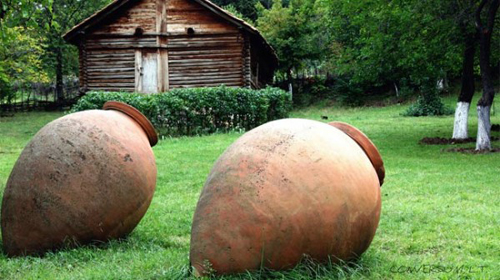
qvevri photo by CONVERSUM
by Mike Madaio
History! Fraud! Intrigue! Politics! What region has it all? Why Georgia, of course. (The country, you mook.)
This republic, located on the eastern coast of the Black Sea, between the southwestern tip of Russia and Turkey, is the very cradle of winemaking, at least says UPenn professor Patrick McGovern, who uncovered evidence of cultivated grapes as far back as 6,000 BC. (If that’s not convincing, the words we use for wine – vin/vino/wine – appear to be derived from the Georgian gvino.)
The story of Georgian wine has taken some interesting turns since those early days. It has been held in high esteem by those with access, including Stalin, a Georgian, who was famously fond of it, and the rest of the Soviet Union, where it was consistently the wine of choice. A number of prohibiting factors, however, including Soviet anti-alcohol campaigns, as well as financial troubles in post-Soviet times (in the face of increased demand from Russia), have led to the development of a lucrative industry of fraud, which includes passing off lower quality wine from other regions, and even worse, artificial beverages made to taste like wine, as Georgian. (In 2006, the New York Times reported that as much as 80% of “Georgian” wine in Russia was fake.)
Also in 2006, at a time when 80% of exported wines were consumed in Russia, Vladimir Putin’s regime placed a ban on all imports of Georgian (as well as Moldovan) wines, under the guise that they had discovered unsafe methods of production, but more likely to exert political pressure on governments that were seen as too sympathetic to the West. Though a crushing blow to the industry at first, it eventually forced Georgian winemakers to look elsewhere for customers, including the US. With increased competition from international producers, it also may have bettered the final product; former president Mikhail Saakashvili famously quipped: “Many thanks to Vladimir Putin for improving the quality of Georgian wine!” The ban has recently been lifted, and the industry has (hopefully) learned its lesson about relying too much one one market.
Georgia’s prime location between the Black Sea, which promotes warm air flow across the country, and below the Caucasian mountains, which protect the country from cold air to the north, features varied micro-climates that are ideal for agriculture. Over 500 grapes are grown (40 used commercially), many of which are indigenous and not found elsewhere. Most important is Saperavi, a red grape that produces deeply-colored, fruity wines that feature a distinct prune flavor, as well as firm acidity and excellent aging potential. Saperavi is also used to make a traditional semi-sweet wine, first developed due to late harvests just before the onset of cold winters that stopped fermentation.
Though I’ve tried semi-sweet Saperavi, it’s not nearly as interesting as the dry wines, which are rich and full-bodied with subtle spice. There’s a signature flavor of prune, that – if I am being perfectly honest – can be strange, especially when it takes the forefront, but also gives Saperavi a truly unique flavor. On Teliani Valley Saperavi Kakheti 2011 ($11.99), for example, I find the prune notes aggressive, whereas with Teliani Valley Mukuzani Kakheti 2010 ($13.99) they are merely a teasing whisper in a bouquet that also features smoke, herbs, berries, anise and even mandarin oranges. For two bucks more, it seems worthwhile to step up, though both are enjoyable and typical of the grape. The Mukuzani is a particularly strong value, offering a balance of deliciousness and depth that would pair perfectly with a variety of foods.
One of the unique legacies of Georgian wine is the use of qvevri (or kvevri) – large clay amphora-like vessels – to ferment and mature wine, a style that dates back to the craft’s origins in the area. In fact, this methodology was recently added to the UNESCO Protected Cultural Heritage list. When we met up to discuss Georgian wine, Max Chania, the PA representative from the Georgian Wine House, was adamant: “Qvevri are not the same as amphorae!” (Apparently this is a sore subject.) They’re much larger, for one, and they are also used to make the wine, not just store it, as is more common for amphorae. Qvevri are buried underground to the neck, a technique that helps maintain an even temperature during cold winters and warm summers.
I tried one Qvevri-made wine, the Vinoterra Saperavi Kakheti 2009 ($18.99). Unlike fully traditional wines, this was also aged in oak after coming out of the clay jars, imparting hints of traditional flavors such as warm spice and tobacco. It was, however, unique, also featuring fresh herbs, earth and violets on the nose and sweet, ripe plums and dark berries on the palate. At $19, it is the finest Georgian wine I have tried and most certainly a bonafide value. Try it with lamb stew or other hearty fare.
It does, of course, paint an incomplete picture of Georgian wine to only discuss reds. Whites are a key part of the wine culture as well, especially the grape Rkatsiteli, which is widely grown throughout Eastern and Central Europe and known for its high acidity. Teliani Valley Tsinandali Kakheti 2011 ($10.99), a blend of Rkatsiteli and Mtsvani, is indeed quite bright, almost similar to a Sauvignon Blanc, with notes of hay, green apple and peach. Simple and straightforward, it is easy to drink.
Having tasted through a variety of Georgian wines with few preconceived expectations, I am especially pleased with the QPR (Quality-Price Ratio). Even the premium bottle, having seen time in both qvevri and oak, is less than $20, and can certainly hold its own against wines from more famous regions that are double or even triple the price. This, combined with the indigenous, unique grapes and intriguing backstory makes a compelling argument that Georgian wine should be on any wine drinker’s radar.
© pavineco.com






